Assignment Prevalence of Bullying among Young Adults at College
VerifiedAdded on 2022/08/29
|13
|2995
|13
AI Summary
Contribute Materials
Your contribution can guide someone’s learning journey. Share your
documents today.
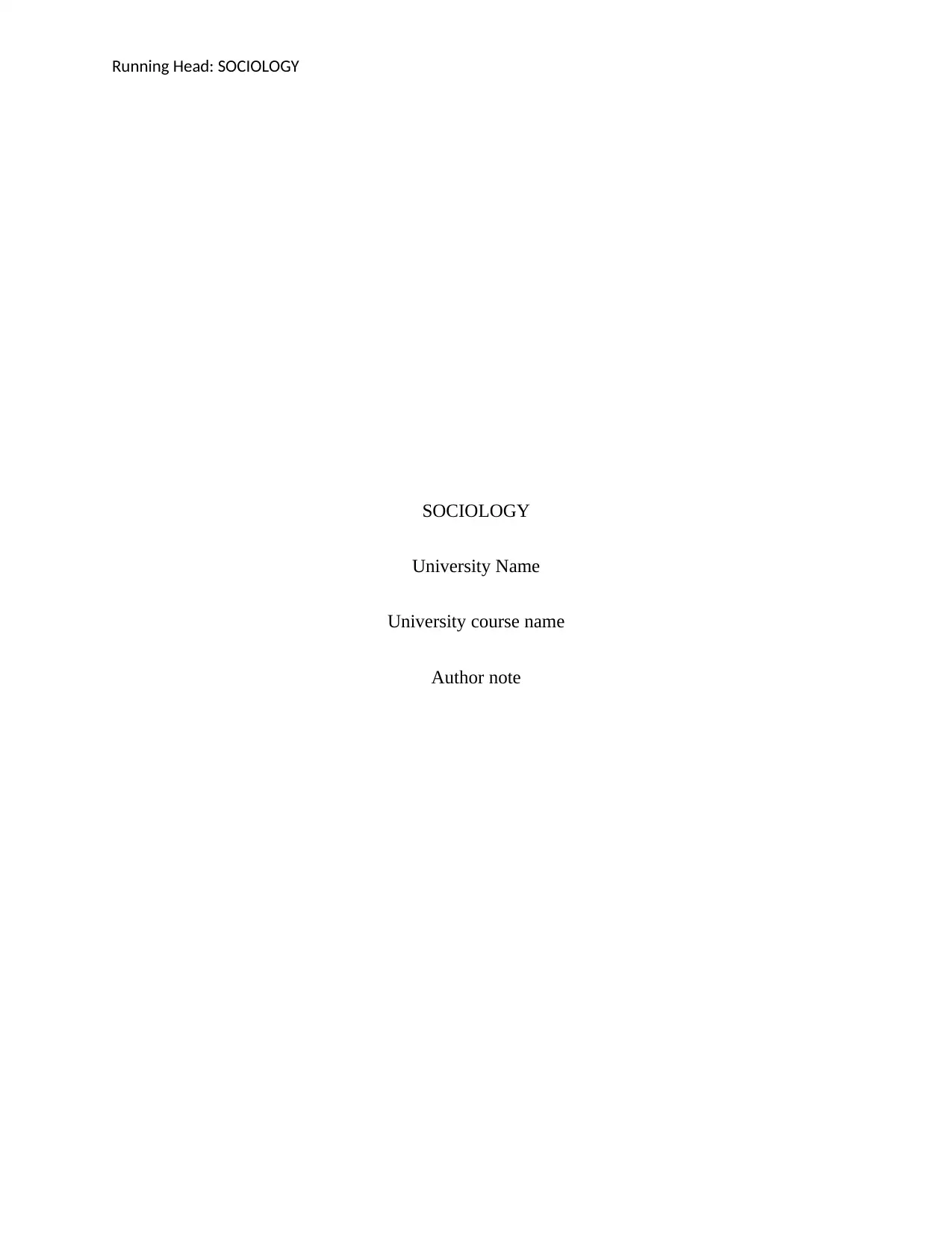
Running Head: SOCIOLOGY
SOCIOLOGY
University Name
University course name
Author note
SOCIOLOGY
University Name
University course name
Author note
Secure Best Marks with AI Grader
Need help grading? Try our AI Grader for instant feedback on your assignments.
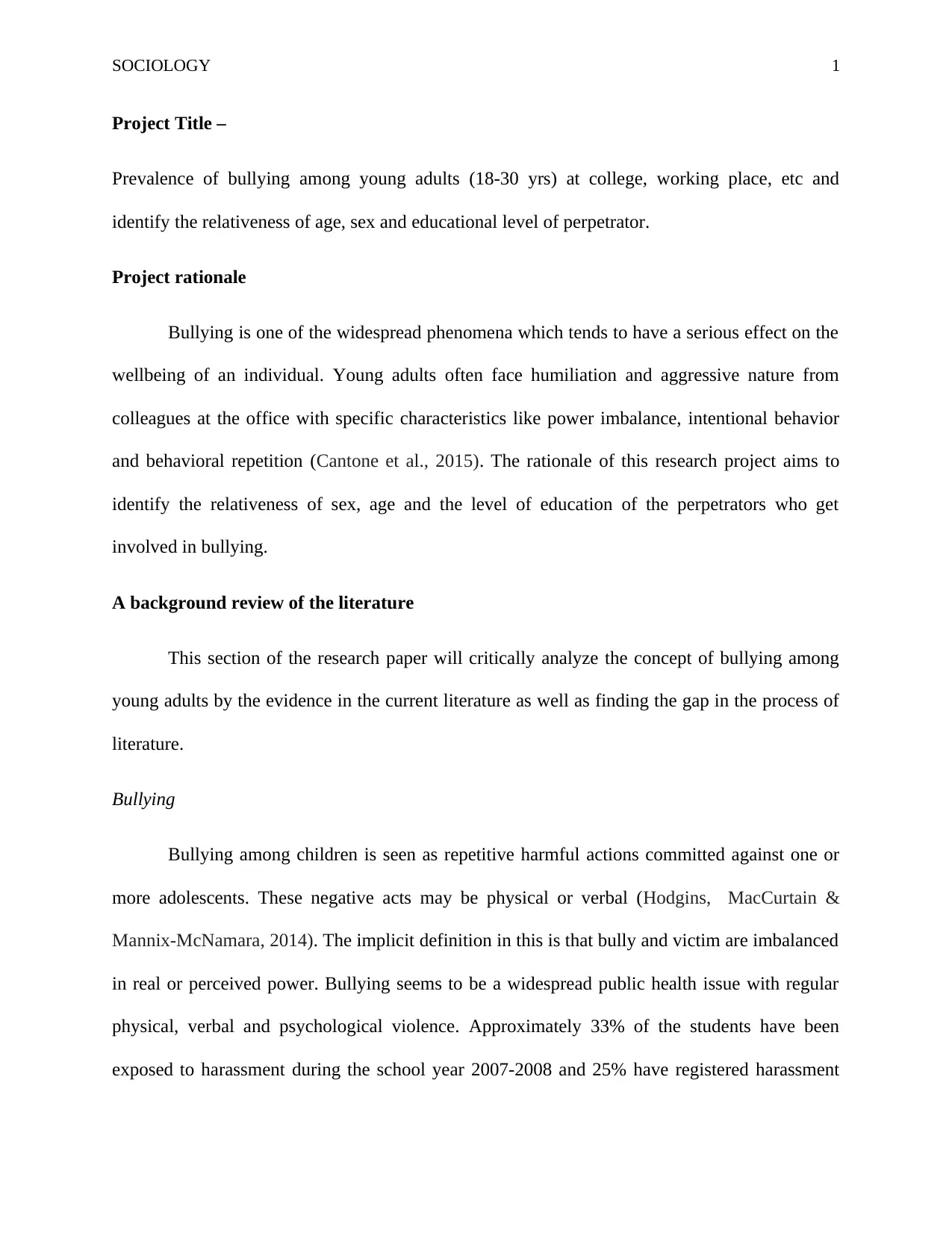
SOCIOLOGY 1
Project Title –
Prevalence of bullying among young adults (18-30 yrs) at college, working place, etc and
identify the relativeness of age, sex and educational level of perpetrator.
Project rationale
Bullying is one of the widespread phenomena which tends to have a serious effect on the
wellbeing of an individual. Young adults often face humiliation and aggressive nature from
colleagues at the office with specific characteristics like power imbalance, intentional behavior
and behavioral repetition (Cantone et al., 2015). The rationale of this research project aims to
identify the relativeness of sex, age and the level of education of the perpetrators who get
involved in bullying.
A background review of the literature
This section of the research paper will critically analyze the concept of bullying among
young adults by the evidence in the current literature as well as finding the gap in the process of
literature.
Bullying
Bullying among children is seen as repetitive harmful actions committed against one or
more adolescents. These negative acts may be physical or verbal (Hodgins, MacCurtain &
Mannix-McNamara, 2014). The implicit definition in this is that bully and victim are imbalanced
in real or perceived power. Bullying seems to be a widespread public health issue with regular
physical, verbal and psychological violence. Approximately 33% of the students have been
exposed to harassment during the school year 2007-2008 and 25% have registered harassment
Project Title –
Prevalence of bullying among young adults (18-30 yrs) at college, working place, etc and
identify the relativeness of age, sex and educational level of perpetrator.
Project rationale
Bullying is one of the widespread phenomena which tends to have a serious effect on the
wellbeing of an individual. Young adults often face humiliation and aggressive nature from
colleagues at the office with specific characteristics like power imbalance, intentional behavior
and behavioral repetition (Cantone et al., 2015). The rationale of this research project aims to
identify the relativeness of sex, age and the level of education of the perpetrators who get
involved in bullying.
A background review of the literature
This section of the research paper will critically analyze the concept of bullying among
young adults by the evidence in the current literature as well as finding the gap in the process of
literature.
Bullying
Bullying among children is seen as repetitive harmful actions committed against one or
more adolescents. These negative acts may be physical or verbal (Hodgins, MacCurtain &
Mannix-McNamara, 2014). The implicit definition in this is that bully and victim are imbalanced
in real or perceived power. Bullying seems to be a widespread public health issue with regular
physical, verbal and psychological violence. Approximately 33% of the students have been
exposed to harassment during the school year 2007-2008 and 25% have registered harassment
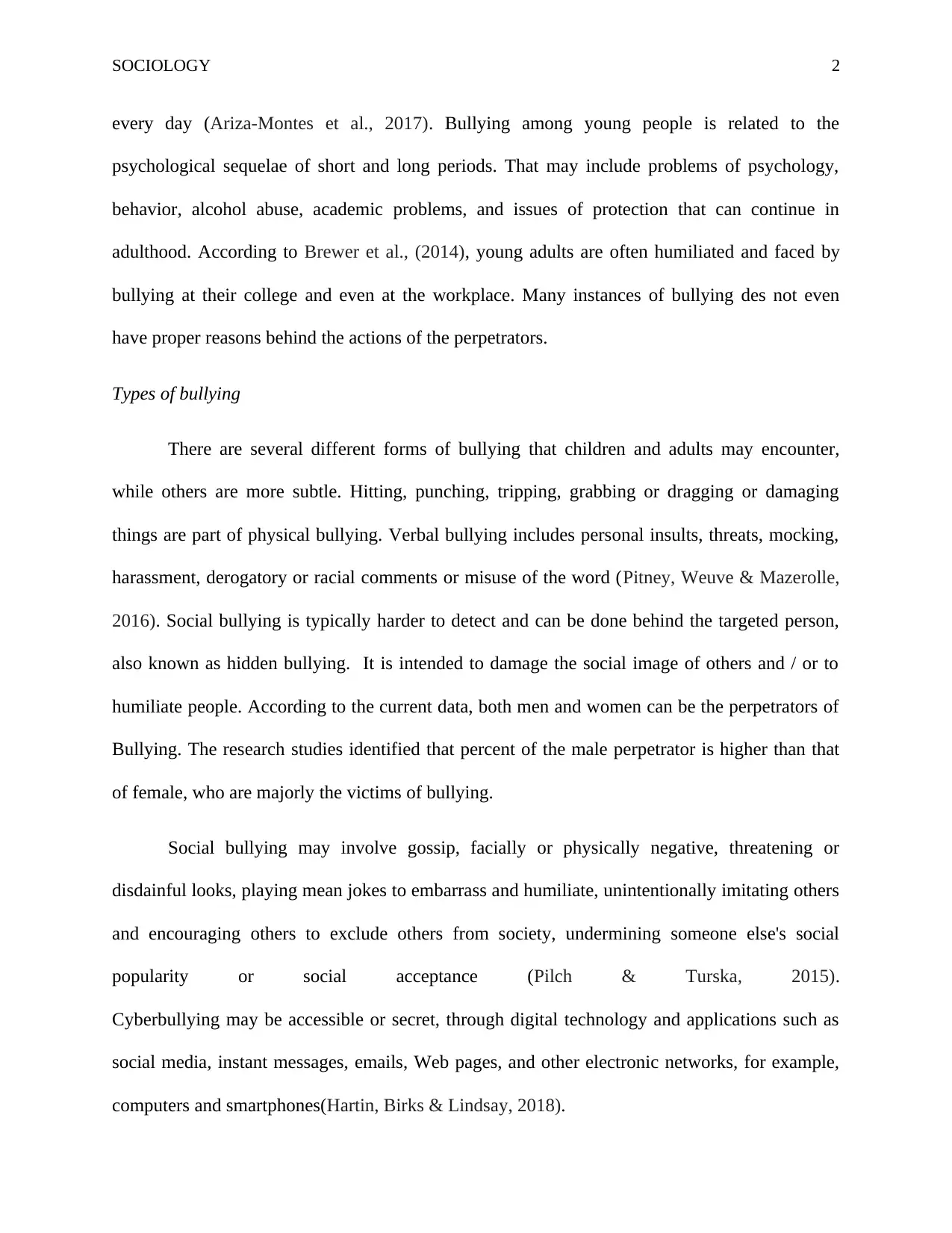
SOCIOLOGY 2
every day (Ariza-Montes et al., 2017). Bullying among young people is related to the
psychological sequelae of short and long periods. That may include problems of psychology,
behavior, alcohol abuse, academic problems, and issues of protection that can continue in
adulthood. According to Brewer et al., (2014), young adults are often humiliated and faced by
bullying at their college and even at the workplace. Many instances of bullying des not even
have proper reasons behind the actions of the perpetrators.
Types of bullying
There are several different forms of bullying that children and adults may encounter,
while others are more subtle. Hitting, punching, tripping, grabbing or dragging or damaging
things are part of physical bullying. Verbal bullying includes personal insults, threats, mocking,
harassment, derogatory or racial comments or misuse of the word (Pitney, Weuve & Mazerolle,
2016). Social bullying is typically harder to detect and can be done behind the targeted person,
also known as hidden bullying. It is intended to damage the social image of others and / or to
humiliate people. According to the current data, both men and women can be the perpetrators of
Bullying. The research studies identified that percent of the male perpetrator is higher than that
of female, who are majorly the victims of bullying.
Social bullying may involve gossip, facially or physically negative, threatening or
disdainful looks, playing mean jokes to embarrass and humiliate, unintentionally imitating others
and encouraging others to exclude others from society, undermining someone else's social
popularity or social acceptance (Pilch & Turska, 2015).
Cyberbullying may be accessible or secret, through digital technology and applications such as
social media, instant messages, emails, Web pages, and other electronic networks, for example,
computers and smartphones(Hartin, Birks & Lindsay, 2018).
every day (Ariza-Montes et al., 2017). Bullying among young people is related to the
psychological sequelae of short and long periods. That may include problems of psychology,
behavior, alcohol abuse, academic problems, and issues of protection that can continue in
adulthood. According to Brewer et al., (2014), young adults are often humiliated and faced by
bullying at their college and even at the workplace. Many instances of bullying des not even
have proper reasons behind the actions of the perpetrators.
Types of bullying
There are several different forms of bullying that children and adults may encounter,
while others are more subtle. Hitting, punching, tripping, grabbing or dragging or damaging
things are part of physical bullying. Verbal bullying includes personal insults, threats, mocking,
harassment, derogatory or racial comments or misuse of the word (Pitney, Weuve & Mazerolle,
2016). Social bullying is typically harder to detect and can be done behind the targeted person,
also known as hidden bullying. It is intended to damage the social image of others and / or to
humiliate people. According to the current data, both men and women can be the perpetrators of
Bullying. The research studies identified that percent of the male perpetrator is higher than that
of female, who are majorly the victims of bullying.
Social bullying may involve gossip, facially or physically negative, threatening or
disdainful looks, playing mean jokes to embarrass and humiliate, unintentionally imitating others
and encouraging others to exclude others from society, undermining someone else's social
popularity or social acceptance (Pilch & Turska, 2015).
Cyberbullying may be accessible or secret, through digital technology and applications such as
social media, instant messages, emails, Web pages, and other electronic networks, for example,
computers and smartphones(Hartin, Birks & Lindsay, 2018).
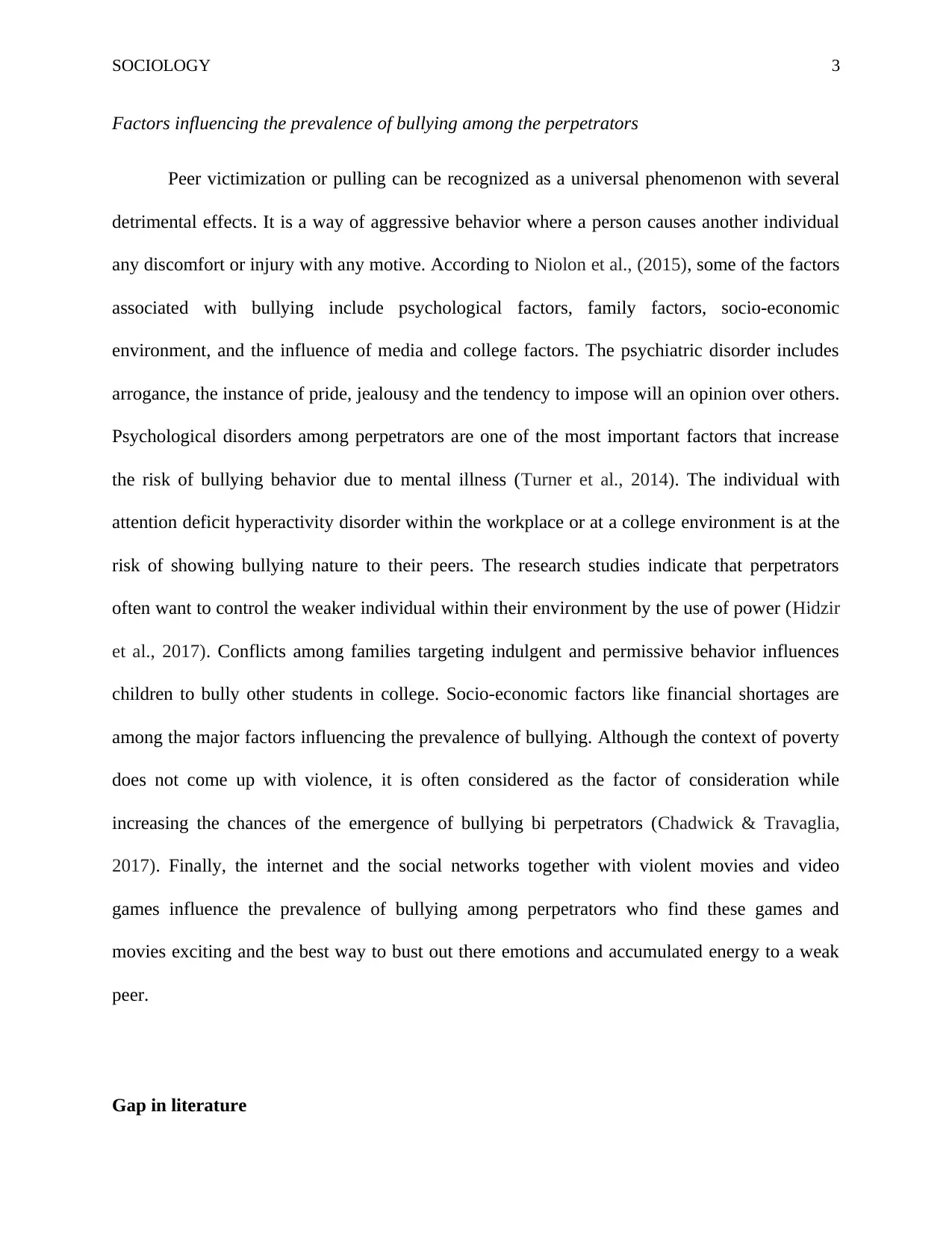
SOCIOLOGY 3
Factors influencing the prevalence of bullying among the perpetrators
Peer victimization or pulling can be recognized as a universal phenomenon with several
detrimental effects. It is a way of aggressive behavior where a person causes another individual
any discomfort or injury with any motive. According to Niolon et al., (2015), some of the factors
associated with bullying include psychological factors, family factors, socio-economic
environment, and the influence of media and college factors. The psychiatric disorder includes
arrogance, the instance of pride, jealousy and the tendency to impose will an opinion over others.
Psychological disorders among perpetrators are one of the most important factors that increase
the risk of bullying behavior due to mental illness (Turner et al., 2014). The individual with
attention deficit hyperactivity disorder within the workplace or at a college environment is at the
risk of showing bullying nature to their peers. The research studies indicate that perpetrators
often want to control the weaker individual within their environment by the use of power (Hidzir
et al., 2017). Conflicts among families targeting indulgent and permissive behavior influences
children to bully other students in college. Socio-economic factors like financial shortages are
among the major factors influencing the prevalence of bullying. Although the context of poverty
does not come up with violence, it is often considered as the factor of consideration while
increasing the chances of the emergence of bullying bi perpetrators (Chadwick & Travaglia,
2017). Finally, the internet and the social networks together with violent movies and video
games influence the prevalence of bullying among perpetrators who find these games and
movies exciting and the best way to bust out there emotions and accumulated energy to a weak
peer.
Gap in literature
Factors influencing the prevalence of bullying among the perpetrators
Peer victimization or pulling can be recognized as a universal phenomenon with several
detrimental effects. It is a way of aggressive behavior where a person causes another individual
any discomfort or injury with any motive. According to Niolon et al., (2015), some of the factors
associated with bullying include psychological factors, family factors, socio-economic
environment, and the influence of media and college factors. The psychiatric disorder includes
arrogance, the instance of pride, jealousy and the tendency to impose will an opinion over others.
Psychological disorders among perpetrators are one of the most important factors that increase
the risk of bullying behavior due to mental illness (Turner et al., 2014). The individual with
attention deficit hyperactivity disorder within the workplace or at a college environment is at the
risk of showing bullying nature to their peers. The research studies indicate that perpetrators
often want to control the weaker individual within their environment by the use of power (Hidzir
et al., 2017). Conflicts among families targeting indulgent and permissive behavior influences
children to bully other students in college. Socio-economic factors like financial shortages are
among the major factors influencing the prevalence of bullying. Although the context of poverty
does not come up with violence, it is often considered as the factor of consideration while
increasing the chances of the emergence of bullying bi perpetrators (Chadwick & Travaglia,
2017). Finally, the internet and the social networks together with violent movies and video
games influence the prevalence of bullying among perpetrators who find these games and
movies exciting and the best way to bust out there emotions and accumulated energy to a weak
peer.
Gap in literature
Secure Best Marks with AI Grader
Need help grading? Try our AI Grader for instant feedback on your assignments.
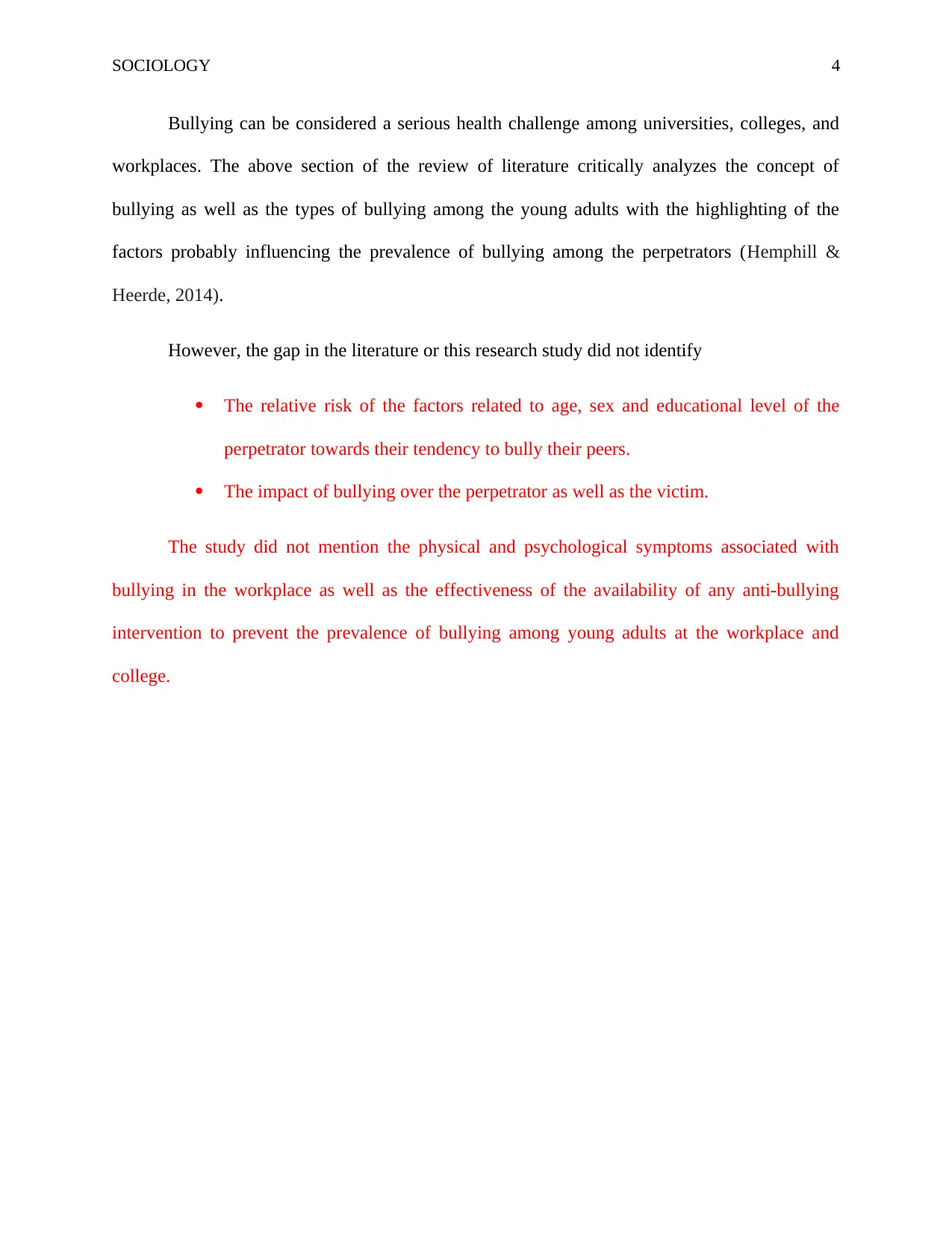
SOCIOLOGY 4
Bullying can be considered a serious health challenge among universities, colleges, and
workplaces. The above section of the review of literature critically analyzes the concept of
bullying as well as the types of bullying among the young adults with the highlighting of the
factors probably influencing the prevalence of bullying among the perpetrators (Hemphill &
Heerde, 2014).
However, the gap in the literature or this research study did not identify
The relative risk of the factors related to age, sex and educational level of the
perpetrator towards their tendency to bully their peers.
The impact of bullying over the perpetrator as well as the victim.
The study did not mention the physical and psychological symptoms associated with
bullying in the workplace as well as the effectiveness of the availability of any anti-bullying
intervention to prevent the prevalence of bullying among young adults at the workplace and
college.
Bullying can be considered a serious health challenge among universities, colleges, and
workplaces. The above section of the review of literature critically analyzes the concept of
bullying as well as the types of bullying among the young adults with the highlighting of the
factors probably influencing the prevalence of bullying among the perpetrators (Hemphill &
Heerde, 2014).
However, the gap in the literature or this research study did not identify
The relative risk of the factors related to age, sex and educational level of the
perpetrator towards their tendency to bully their peers.
The impact of bullying over the perpetrator as well as the victim.
The study did not mention the physical and psychological symptoms associated with
bullying in the workplace as well as the effectiveness of the availability of any anti-bullying
intervention to prevent the prevalence of bullying among young adults at the workplace and
college.
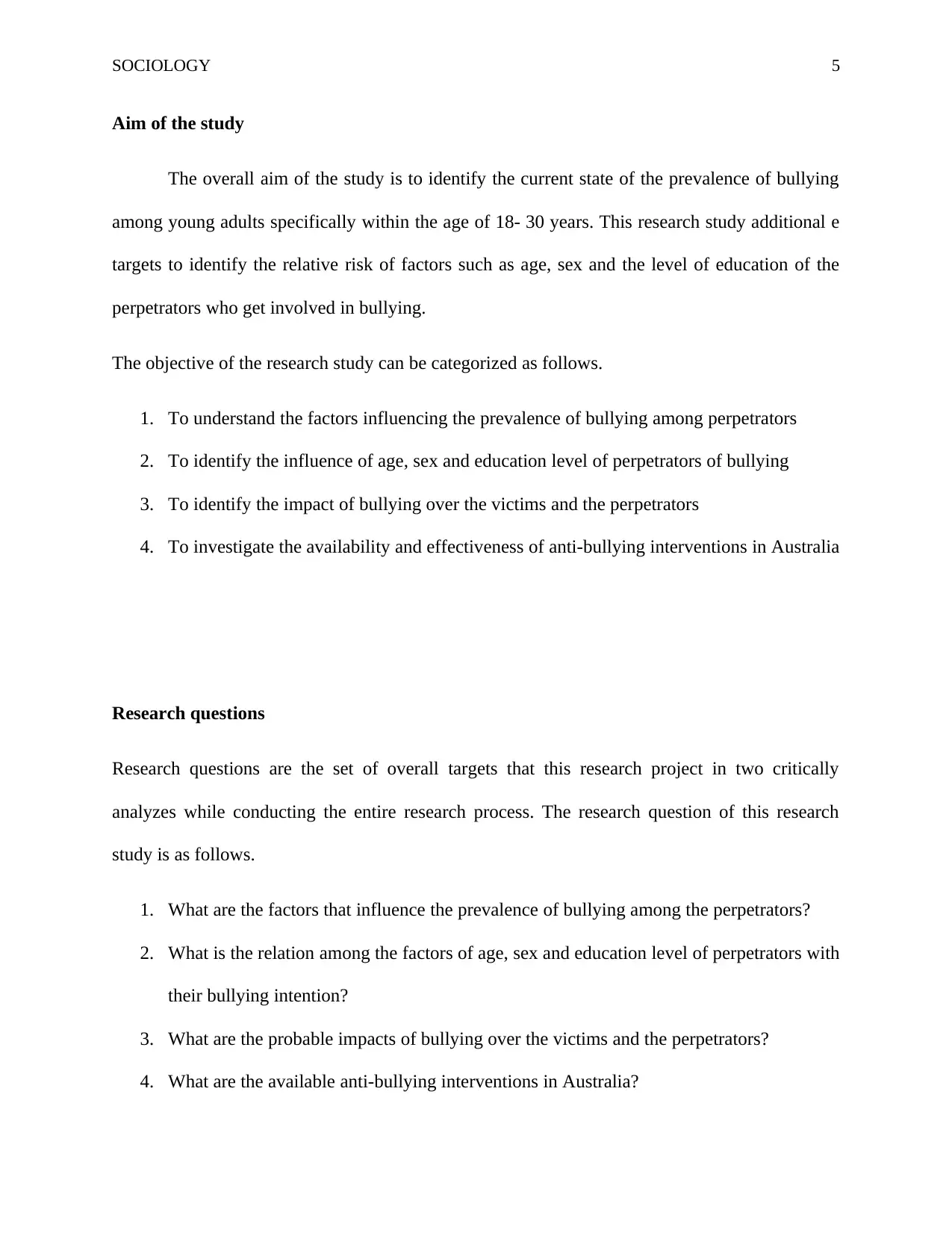
SOCIOLOGY 5
Aim of the study
The overall aim of the study is to identify the current state of the prevalence of bullying
among young adults specifically within the age of 18- 30 years. This research study additional e
targets to identify the relative risk of factors such as age, sex and the level of education of the
perpetrators who get involved in bullying.
The objective of the research study can be categorized as follows.
1. To understand the factors influencing the prevalence of bullying among perpetrators
2. To identify the influence of age, sex and education level of perpetrators of bullying
3. To identify the impact of bullying over the victims and the perpetrators
4. To investigate the availability and effectiveness of anti-bullying interventions in Australia
Research questions
Research questions are the set of overall targets that this research project in two critically
analyzes while conducting the entire research process. The research question of this research
study is as follows.
1. What are the factors that influence the prevalence of bullying among the perpetrators?
2. What is the relation among the factors of age, sex and education level of perpetrators with
their bullying intention?
3. What are the probable impacts of bullying over the victims and the perpetrators?
4. What are the available anti-bullying interventions in Australia?
Aim of the study
The overall aim of the study is to identify the current state of the prevalence of bullying
among young adults specifically within the age of 18- 30 years. This research study additional e
targets to identify the relative risk of factors such as age, sex and the level of education of the
perpetrators who get involved in bullying.
The objective of the research study can be categorized as follows.
1. To understand the factors influencing the prevalence of bullying among perpetrators
2. To identify the influence of age, sex and education level of perpetrators of bullying
3. To identify the impact of bullying over the victims and the perpetrators
4. To investigate the availability and effectiveness of anti-bullying interventions in Australia
Research questions
Research questions are the set of overall targets that this research project in two critically
analyzes while conducting the entire research process. The research question of this research
study is as follows.
1. What are the factors that influence the prevalence of bullying among the perpetrators?
2. What is the relation among the factors of age, sex and education level of perpetrators with
their bullying intention?
3. What are the probable impacts of bullying over the victims and the perpetrators?
4. What are the available anti-bullying interventions in Australia?
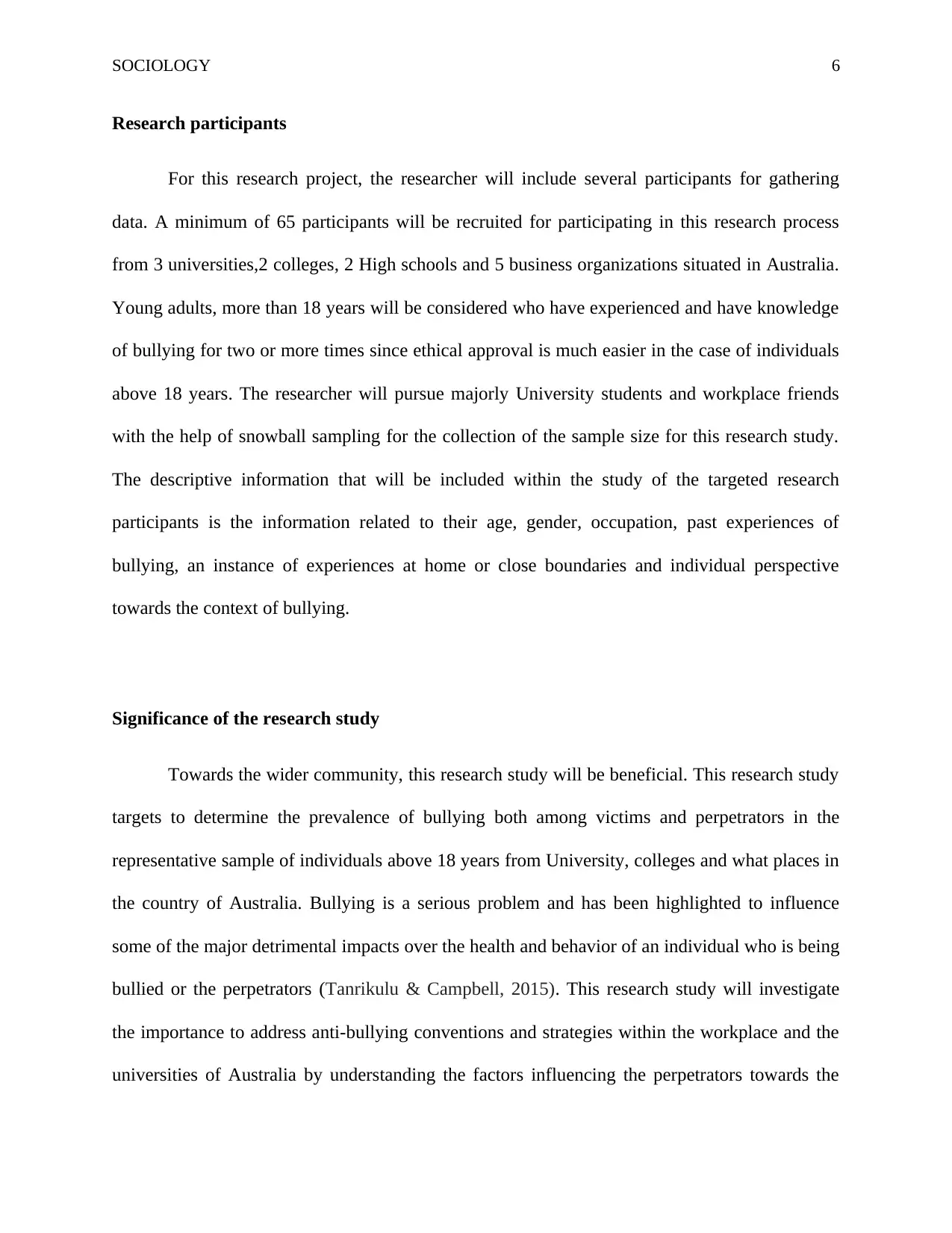
SOCIOLOGY 6
Research participants
For this research project, the researcher will include several participants for gathering
data. A minimum of 65 participants will be recruited for participating in this research process
from 3 universities,2 colleges, 2 High schools and 5 business organizations situated in Australia.
Young adults, more than 18 years will be considered who have experienced and have knowledge
of bullying for two or more times since ethical approval is much easier in the case of individuals
above 18 years. The researcher will pursue majorly University students and workplace friends
with the help of snowball sampling for the collection of the sample size for this research study.
The descriptive information that will be included within the study of the targeted research
participants is the information related to their age, gender, occupation, past experiences of
bullying, an instance of experiences at home or close boundaries and individual perspective
towards the context of bullying.
Significance of the research study
Towards the wider community, this research study will be beneficial. This research study
targets to determine the prevalence of bullying both among victims and perpetrators in the
representative sample of individuals above 18 years from University, colleges and what places in
the country of Australia. Bullying is a serious problem and has been highlighted to influence
some of the major detrimental impacts over the health and behavior of an individual who is being
bullied or the perpetrators (Tanrikulu & Campbell, 2015). This research study will investigate
the importance to address anti-bullying conventions and strategies within the workplace and the
universities of Australia by understanding the factors influencing the perpetrators towards the
Research participants
For this research project, the researcher will include several participants for gathering
data. A minimum of 65 participants will be recruited for participating in this research process
from 3 universities,2 colleges, 2 High schools and 5 business organizations situated in Australia.
Young adults, more than 18 years will be considered who have experienced and have knowledge
of bullying for two or more times since ethical approval is much easier in the case of individuals
above 18 years. The researcher will pursue majorly University students and workplace friends
with the help of snowball sampling for the collection of the sample size for this research study.
The descriptive information that will be included within the study of the targeted research
participants is the information related to their age, gender, occupation, past experiences of
bullying, an instance of experiences at home or close boundaries and individual perspective
towards the context of bullying.
Significance of the research study
Towards the wider community, this research study will be beneficial. This research study
targets to determine the prevalence of bullying both among victims and perpetrators in the
representative sample of individuals above 18 years from University, colleges and what places in
the country of Australia. Bullying is a serious problem and has been highlighted to influence
some of the major detrimental impacts over the health and behavior of an individual who is being
bullied or the perpetrators (Tanrikulu & Campbell, 2015). This research study will investigate
the importance to address anti-bullying conventions and strategies within the workplace and the
universities of Australia by understanding the factors influencing the perpetrators towards the
Paraphrase This Document
Need a fresh take? Get an instant paraphrase of this document with our AI Paraphraser
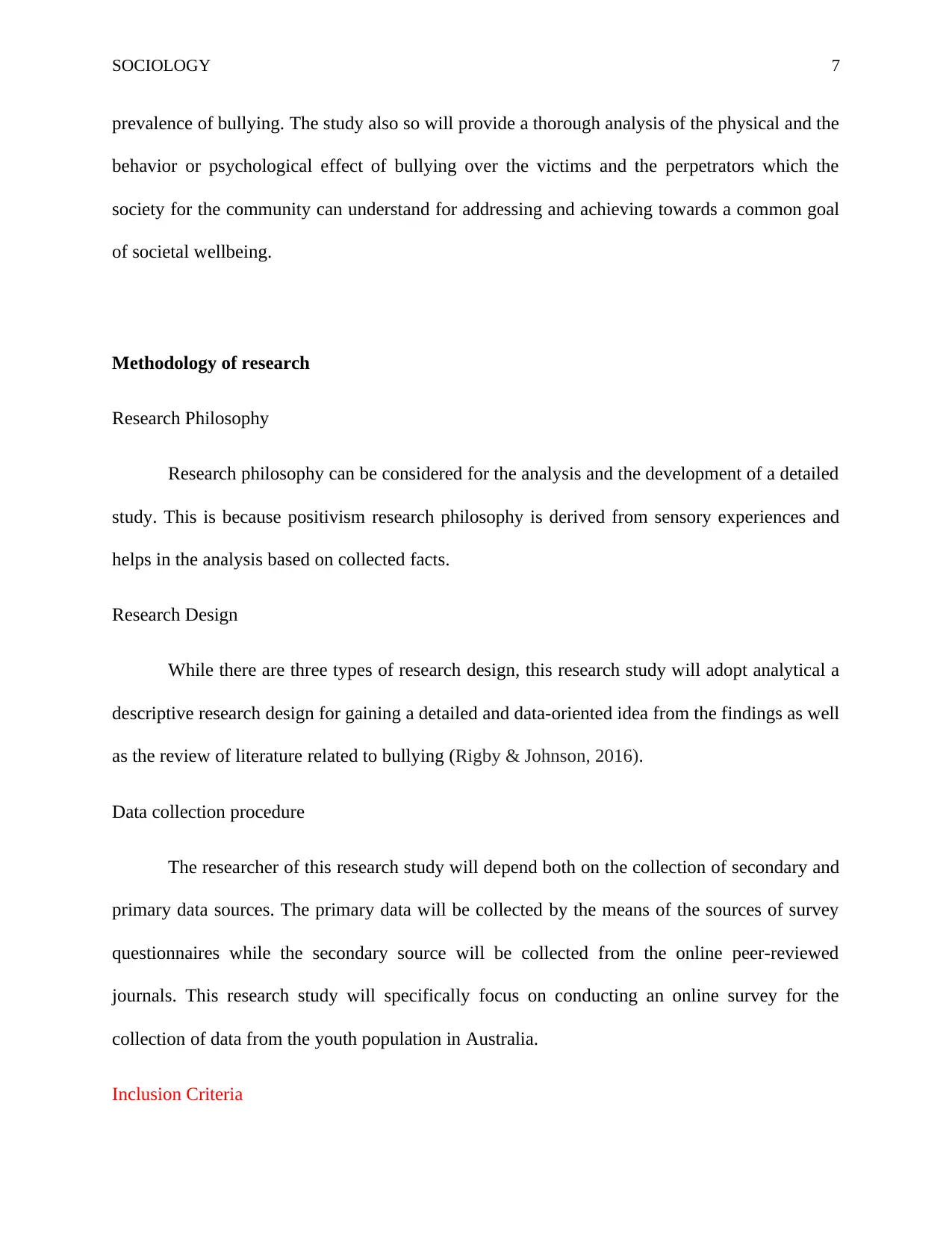
SOCIOLOGY 7
prevalence of bullying. The study also so will provide a thorough analysis of the physical and the
behavior or psychological effect of bullying over the victims and the perpetrators which the
society for the community can understand for addressing and achieving towards a common goal
of societal wellbeing.
Methodology of research
Research Philosophy
Research philosophy can be considered for the analysis and the development of a detailed
study. This is because positivism research philosophy is derived from sensory experiences and
helps in the analysis based on collected facts.
Research Design
While there are three types of research design, this research study will adopt analytical a
descriptive research design for gaining a detailed and data-oriented idea from the findings as well
as the review of literature related to bullying (Rigby & Johnson, 2016).
Data collection procedure
The researcher of this research study will depend both on the collection of secondary and
primary data sources. The primary data will be collected by the means of the sources of survey
questionnaires while the secondary source will be collected from the online peer-reviewed
journals. This research study will specifically focus on conducting an online survey for the
collection of data from the youth population in Australia.
Inclusion Criteria
prevalence of bullying. The study also so will provide a thorough analysis of the physical and the
behavior or psychological effect of bullying over the victims and the perpetrators which the
society for the community can understand for addressing and achieving towards a common goal
of societal wellbeing.
Methodology of research
Research Philosophy
Research philosophy can be considered for the analysis and the development of a detailed
study. This is because positivism research philosophy is derived from sensory experiences and
helps in the analysis based on collected facts.
Research Design
While there are three types of research design, this research study will adopt analytical a
descriptive research design for gaining a detailed and data-oriented idea from the findings as well
as the review of literature related to bullying (Rigby & Johnson, 2016).
Data collection procedure
The researcher of this research study will depend both on the collection of secondary and
primary data sources. The primary data will be collected by the means of the sources of survey
questionnaires while the secondary source will be collected from the online peer-reviewed
journals. This research study will specifically focus on conducting an online survey for the
collection of data from the youth population in Australia.
Inclusion Criteria
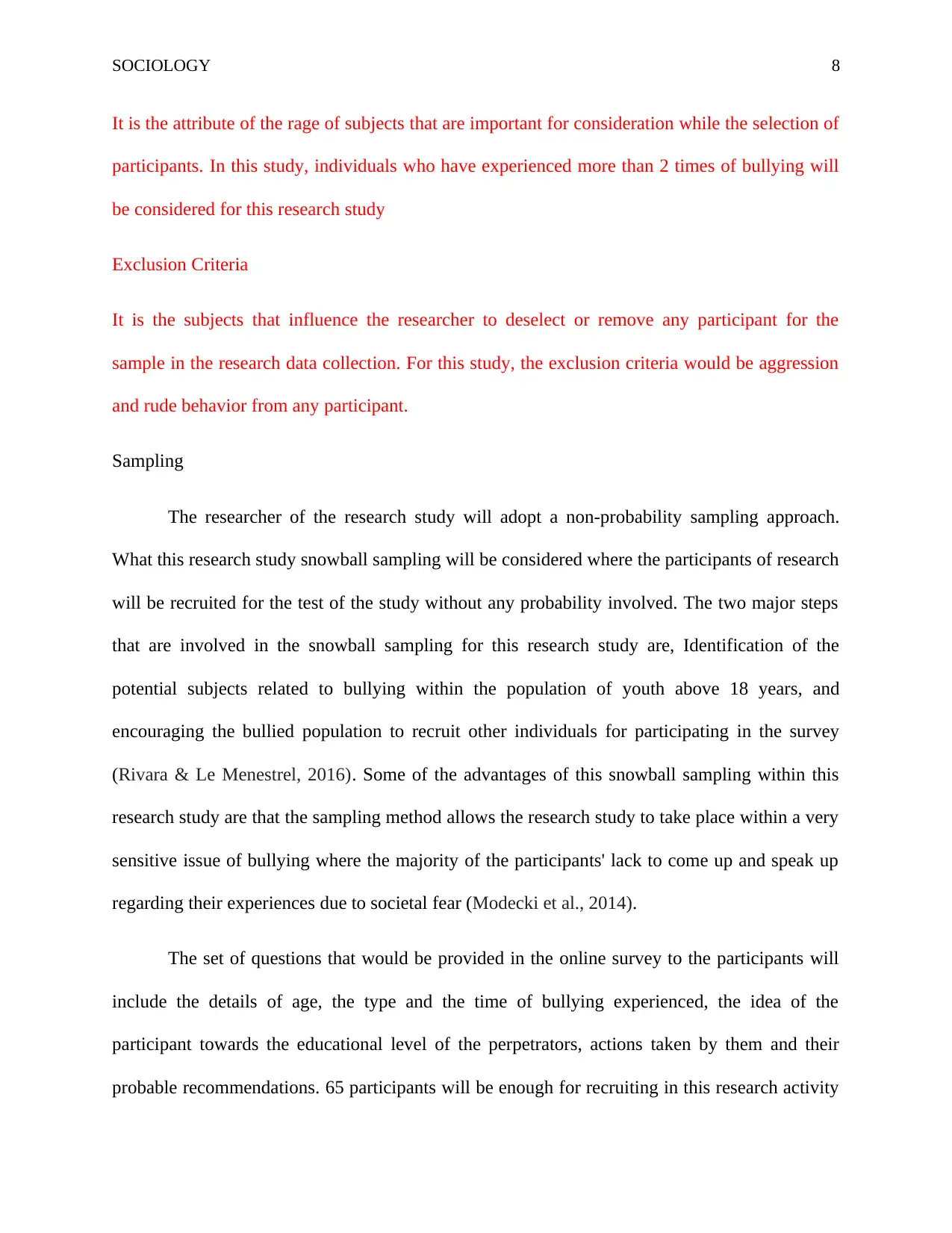
SOCIOLOGY 8
It is the attribute of the rage of subjects that are important for consideration while the selection of
participants. In this study, individuals who have experienced more than 2 times of bullying will
be considered for this research study
Exclusion Criteria
It is the subjects that influence the researcher to deselect or remove any participant for the
sample in the research data collection. For this study, the exclusion criteria would be aggression
and rude behavior from any participant.
Sampling
The researcher of the research study will adopt a non-probability sampling approach.
What this research study snowball sampling will be considered where the participants of research
will be recruited for the test of the study without any probability involved. The two major steps
that are involved in the snowball sampling for this research study are, Identification of the
potential subjects related to bullying within the population of youth above 18 years, and
encouraging the bullied population to recruit other individuals for participating in the survey
(Rivara & Le Menestrel, 2016). Some of the advantages of this snowball sampling within this
research study are that the sampling method allows the research study to take place within a very
sensitive issue of bullying where the majority of the participants' lack to come up and speak up
regarding their experiences due to societal fear (Modecki et al., 2014).
The set of questions that would be provided in the online survey to the participants will
include the details of age, the type and the time of bullying experienced, the idea of the
participant towards the educational level of the perpetrators, actions taken by them and their
probable recommendations. 65 participants will be enough for recruiting in this research activity
It is the attribute of the rage of subjects that are important for consideration while the selection of
participants. In this study, individuals who have experienced more than 2 times of bullying will
be considered for this research study
Exclusion Criteria
It is the subjects that influence the researcher to deselect or remove any participant for the
sample in the research data collection. For this study, the exclusion criteria would be aggression
and rude behavior from any participant.
Sampling
The researcher of the research study will adopt a non-probability sampling approach.
What this research study snowball sampling will be considered where the participants of research
will be recruited for the test of the study without any probability involved. The two major steps
that are involved in the snowball sampling for this research study are, Identification of the
potential subjects related to bullying within the population of youth above 18 years, and
encouraging the bullied population to recruit other individuals for participating in the survey
(Rivara & Le Menestrel, 2016). Some of the advantages of this snowball sampling within this
research study are that the sampling method allows the research study to take place within a very
sensitive issue of bullying where the majority of the participants' lack to come up and speak up
regarding their experiences due to societal fear (Modecki et al., 2014).
The set of questions that would be provided in the online survey to the participants will
include the details of age, the type and the time of bullying experienced, the idea of the
participant towards the educational level of the perpetrators, actions taken by them and their
probable recommendations. 65 participants will be enough for recruiting in this research activity

SOCIOLOGY 9
for understanding the current rate of prevalence of bullying within several sectors in Australia.
The researcher will ensure that the collected group of participants that will be studied in the
sample belongs to the age group of 18 -30 years. The entire server procedure will focus majorly
on the survey questionnaire in the research study.
Data analysis
For carrying out the analysis of the collected quantitative data by the means of a survey,
the researcher of the study will transform all the data to the percentage as and numeric for
gaining a comprehensive and a comparison data of the collected information. The researcher will
evaluate the data by involving reach descriptive statistics and the inclusion of inferential
statistics, standard deviation and linear regression model. The evaluation of the qualitative data
will be done by the use of a thematic approach where several themes will be applied for relating
to the topic of research.
for understanding the current rate of prevalence of bullying within several sectors in Australia.
The researcher will ensure that the collected group of participants that will be studied in the
sample belongs to the age group of 18 -30 years. The entire server procedure will focus majorly
on the survey questionnaire in the research study.
Data analysis
For carrying out the analysis of the collected quantitative data by the means of a survey,
the researcher of the study will transform all the data to the percentage as and numeric for
gaining a comprehensive and a comparison data of the collected information. The researcher will
evaluate the data by involving reach descriptive statistics and the inclusion of inferential
statistics, standard deviation and linear regression model. The evaluation of the qualitative data
will be done by the use of a thematic approach where several themes will be applied for relating
to the topic of research.
Secure Best Marks with AI Grader
Need help grading? Try our AI Grader for instant feedback on your assignments.
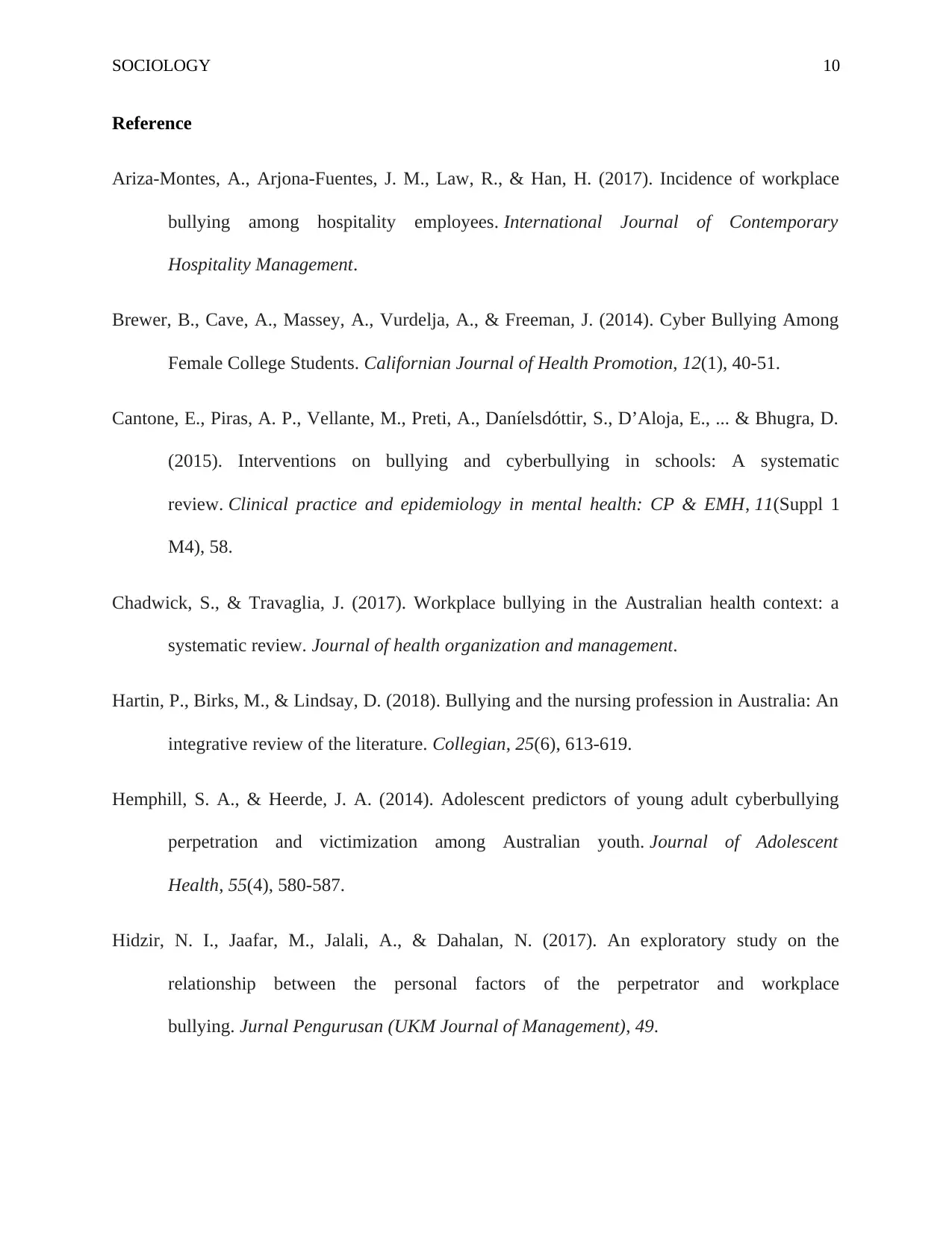
SOCIOLOGY 10
Reference
Ariza-Montes, A., Arjona-Fuentes, J. M., Law, R., & Han, H. (2017). Incidence of workplace
bullying among hospitality employees. International Journal of Contemporary
Hospitality Management.
Brewer, B., Cave, A., Massey, A., Vurdelja, A., & Freeman, J. (2014). Cyber Bullying Among
Female College Students. Californian Journal of Health Promotion, 12(1), 40-51.
Cantone, E., Piras, A. P., Vellante, M., Preti, A., Daníelsdóttir, S., D’Aloja, E., ... & Bhugra, D.
(2015). Interventions on bullying and cyberbullying in schools: A systematic
review. Clinical practice and epidemiology in mental health: CP & EMH, 11(Suppl 1
M4), 58.
Chadwick, S., & Travaglia, J. (2017). Workplace bullying in the Australian health context: a
systematic review. Journal of health organization and management.
Hartin, P., Birks, M., & Lindsay, D. (2018). Bullying and the nursing profession in Australia: An
integrative review of the literature. Collegian, 25(6), 613-619.
Hemphill, S. A., & Heerde, J. A. (2014). Adolescent predictors of young adult cyberbullying
perpetration and victimization among Australian youth. Journal of Adolescent
Health, 55(4), 580-587.
Hidzir, N. I., Jaafar, M., Jalali, A., & Dahalan, N. (2017). An exploratory study on the
relationship between the personal factors of the perpetrator and workplace
bullying. Jurnal Pengurusan (UKM Journal of Management), 49.
Reference
Ariza-Montes, A., Arjona-Fuentes, J. M., Law, R., & Han, H. (2017). Incidence of workplace
bullying among hospitality employees. International Journal of Contemporary
Hospitality Management.
Brewer, B., Cave, A., Massey, A., Vurdelja, A., & Freeman, J. (2014). Cyber Bullying Among
Female College Students. Californian Journal of Health Promotion, 12(1), 40-51.
Cantone, E., Piras, A. P., Vellante, M., Preti, A., Daníelsdóttir, S., D’Aloja, E., ... & Bhugra, D.
(2015). Interventions on bullying and cyberbullying in schools: A systematic
review. Clinical practice and epidemiology in mental health: CP & EMH, 11(Suppl 1
M4), 58.
Chadwick, S., & Travaglia, J. (2017). Workplace bullying in the Australian health context: a
systematic review. Journal of health organization and management.
Hartin, P., Birks, M., & Lindsay, D. (2018). Bullying and the nursing profession in Australia: An
integrative review of the literature. Collegian, 25(6), 613-619.
Hemphill, S. A., & Heerde, J. A. (2014). Adolescent predictors of young adult cyberbullying
perpetration and victimization among Australian youth. Journal of Adolescent
Health, 55(4), 580-587.
Hidzir, N. I., Jaafar, M., Jalali, A., & Dahalan, N. (2017). An exploratory study on the
relationship between the personal factors of the perpetrator and workplace
bullying. Jurnal Pengurusan (UKM Journal of Management), 49.
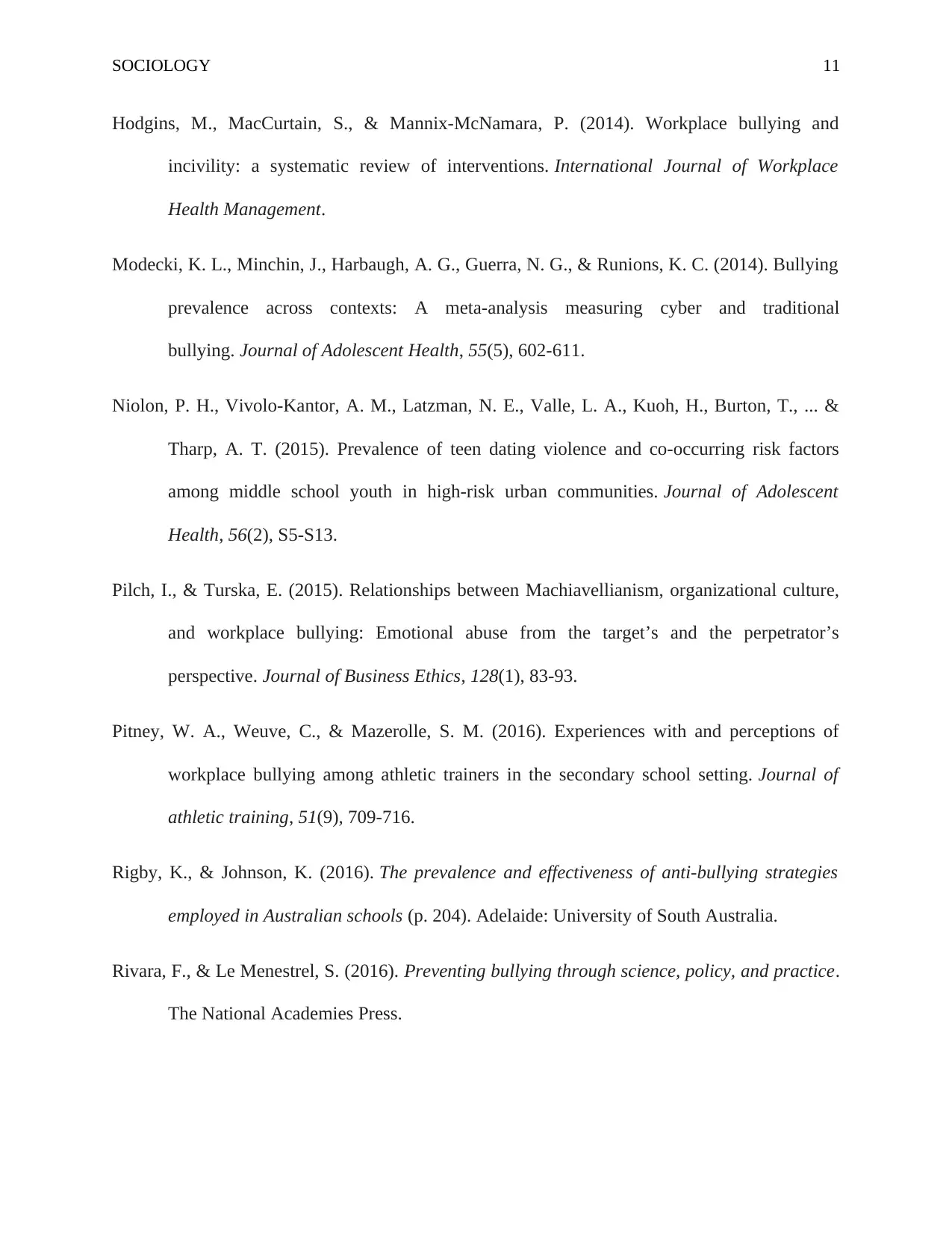
SOCIOLOGY 11
Hodgins, M., MacCurtain, S., & Mannix-McNamara, P. (2014). Workplace bullying and
incivility: a systematic review of interventions. International Journal of Workplace
Health Management.
Modecki, K. L., Minchin, J., Harbaugh, A. G., Guerra, N. G., & Runions, K. C. (2014). Bullying
prevalence across contexts: A meta-analysis measuring cyber and traditional
bullying. Journal of Adolescent Health, 55(5), 602-611.
Niolon, P. H., Vivolo-Kantor, A. M., Latzman, N. E., Valle, L. A., Kuoh, H., Burton, T., ... &
Tharp, A. T. (2015). Prevalence of teen dating violence and co-occurring risk factors
among middle school youth in high-risk urban communities. Journal of Adolescent
Health, 56(2), S5-S13.
Pilch, I., & Turska, E. (2015). Relationships between Machiavellianism, organizational culture,
and workplace bullying: Emotional abuse from the target’s and the perpetrator’s
perspective. Journal of Business Ethics, 128(1), 83-93.
Pitney, W. A., Weuve, C., & Mazerolle, S. M. (2016). Experiences with and perceptions of
workplace bullying among athletic trainers in the secondary school setting. Journal of
athletic training, 51(9), 709-716.
Rigby, K., & Johnson, K. (2016). The prevalence and effectiveness of anti-bullying strategies
employed in Australian schools (p. 204). Adelaide: University of South Australia.
Rivara, F., & Le Menestrel, S. (2016). Preventing bullying through science, policy, and practice.
The National Academies Press.
Hodgins, M., MacCurtain, S., & Mannix-McNamara, P. (2014). Workplace bullying and
incivility: a systematic review of interventions. International Journal of Workplace
Health Management.
Modecki, K. L., Minchin, J., Harbaugh, A. G., Guerra, N. G., & Runions, K. C. (2014). Bullying
prevalence across contexts: A meta-analysis measuring cyber and traditional
bullying. Journal of Adolescent Health, 55(5), 602-611.
Niolon, P. H., Vivolo-Kantor, A. M., Latzman, N. E., Valle, L. A., Kuoh, H., Burton, T., ... &
Tharp, A. T. (2015). Prevalence of teen dating violence and co-occurring risk factors
among middle school youth in high-risk urban communities. Journal of Adolescent
Health, 56(2), S5-S13.
Pilch, I., & Turska, E. (2015). Relationships between Machiavellianism, organizational culture,
and workplace bullying: Emotional abuse from the target’s and the perpetrator’s
perspective. Journal of Business Ethics, 128(1), 83-93.
Pitney, W. A., Weuve, C., & Mazerolle, S. M. (2016). Experiences with and perceptions of
workplace bullying among athletic trainers in the secondary school setting. Journal of
athletic training, 51(9), 709-716.
Rigby, K., & Johnson, K. (2016). The prevalence and effectiveness of anti-bullying strategies
employed in Australian schools (p. 204). Adelaide: University of South Australia.
Rivara, F., & Le Menestrel, S. (2016). Preventing bullying through science, policy, and practice.
The National Academies Press.
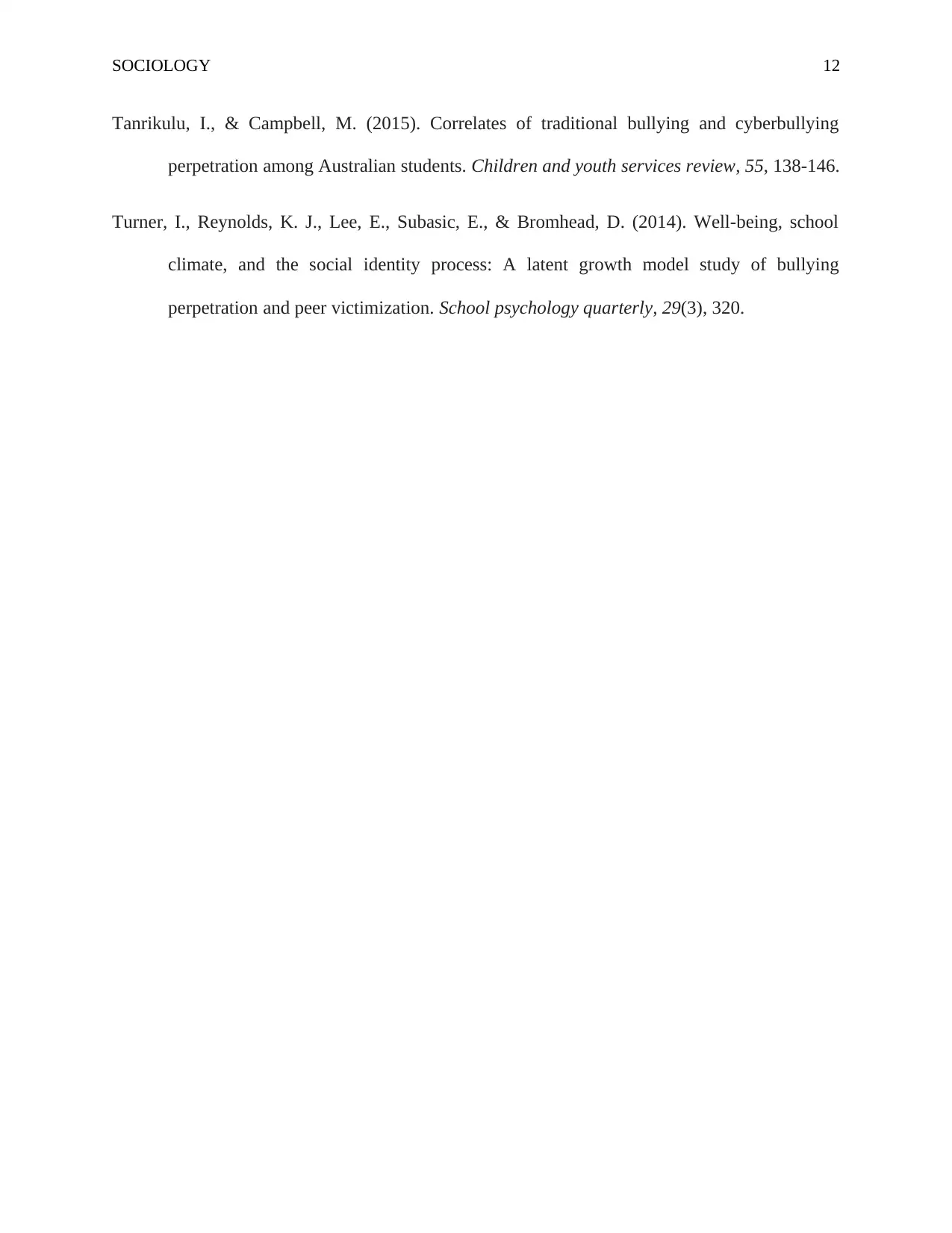
SOCIOLOGY 12
Tanrikulu, I., & Campbell, M. (2015). Correlates of traditional bullying and cyberbullying
perpetration among Australian students. Children and youth services review, 55, 138-146.
Turner, I., Reynolds, K. J., Lee, E., Subasic, E., & Bromhead, D. (2014). Well-being, school
climate, and the social identity process: A latent growth model study of bullying
perpetration and peer victimization. School psychology quarterly, 29(3), 320.
Tanrikulu, I., & Campbell, M. (2015). Correlates of traditional bullying and cyberbullying
perpetration among Australian students. Children and youth services review, 55, 138-146.
Turner, I., Reynolds, K. J., Lee, E., Subasic, E., & Bromhead, D. (2014). Well-being, school
climate, and the social identity process: A latent growth model study of bullying
perpetration and peer victimization. School psychology quarterly, 29(3), 320.
1 out of 13
Related Documents
Your All-in-One AI-Powered Toolkit for Academic Success.
+13062052269
info@desklib.com
Available 24*7 on WhatsApp / Email
![[object Object]](/_next/static/media/star-bottom.7253800d.svg)
Unlock your academic potential
© 2024 | Zucol Services PVT LTD | All rights reserved.





